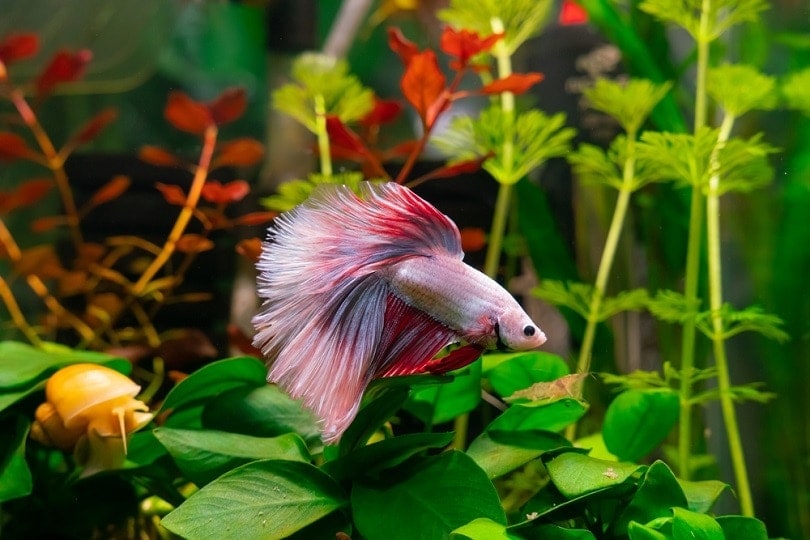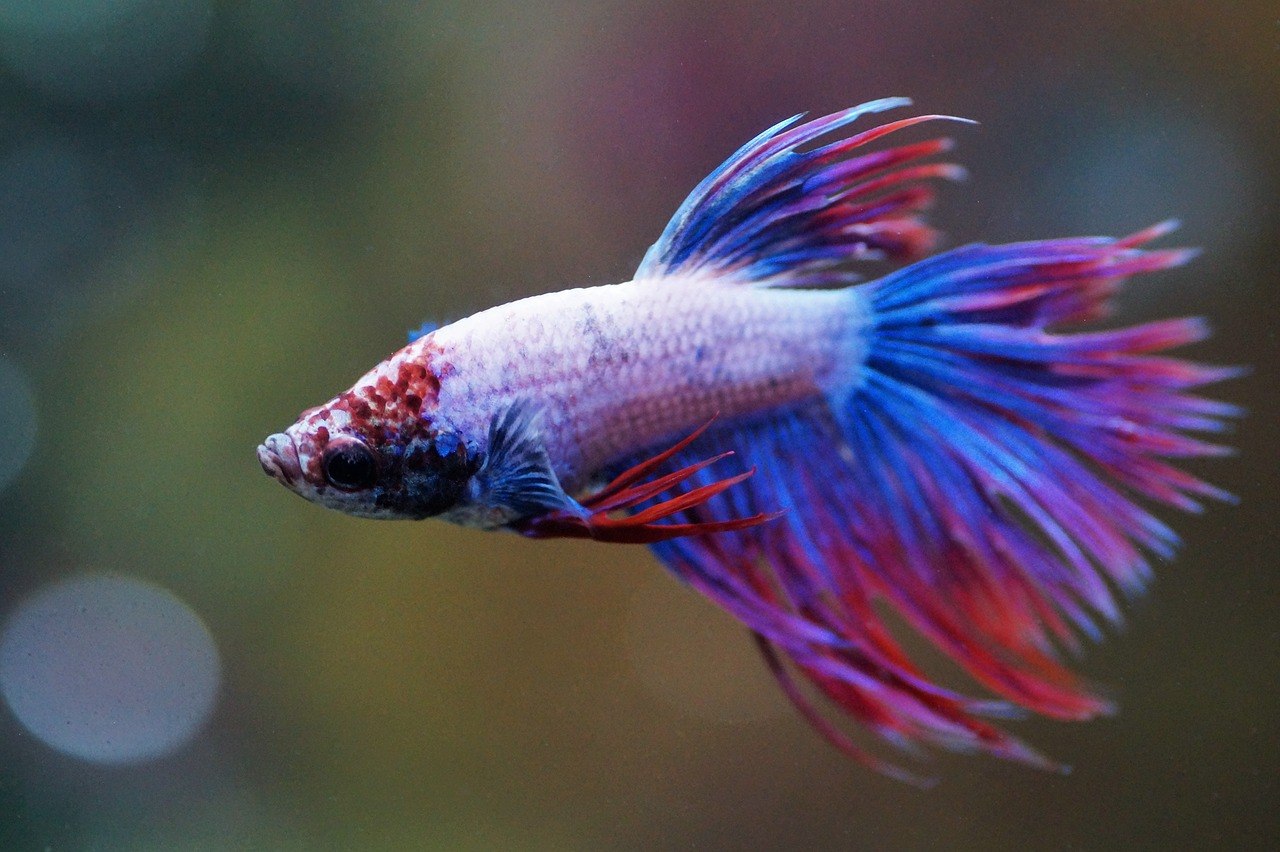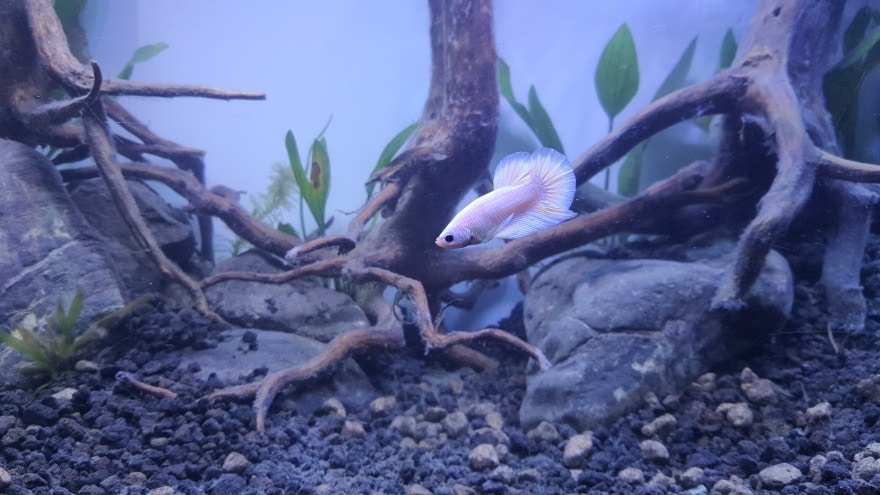Red Betta Fish: Care Guide, Pictures, Varieties, Lifespan & More

Updated on
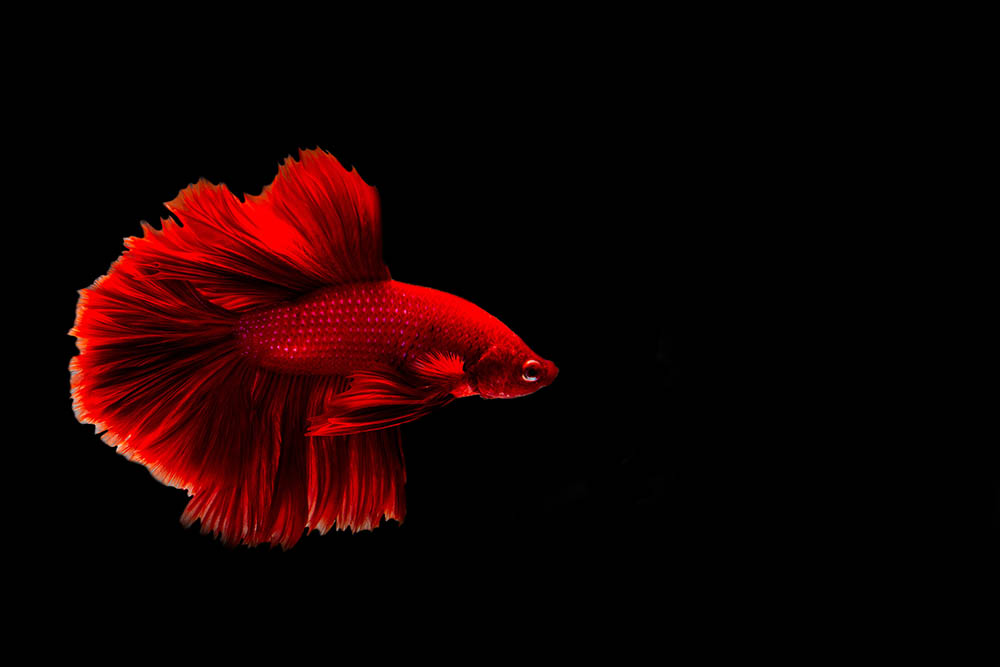
Click to Skip Ahead
The Red Betta Fish isn’t your average critter. While it’s related to the more familiar species, it is a unique fish, albeit with similar care. You may see it by this name or called the Scarlet Betta Fish. The color is the meaning of its species name. Though not as common, it is worth seeking out because of its temperament and interesting color pattern.
Quick Facts about Red Betta Fish
| Species Name: | Betta coccina |
| Family: | Osphronemidae |
| Care Level: | Moderate |
| Temperature: | 72–80℉ |
| Temperament: | Social |
| Color Form: | Red or scarlet |
| Lifespan: | 2–5 years |
| Size: | Up to 2.5” L |
| Diet: | Live foods and insects |
| Minimum Tank Size: | 5 gallons for a pair |
| Tank Set-Up: | Live plants with plenty of hiding places |
| Compatibility: | Other docile, schooling species |
Red Betta Fish Overview
You’ll often see this fish listed as part of the Coccina complex group of species. There are 10 species in this category that are all quite similar with slight color variations and additional markings. That means that you may get a fish that looks different than the ones you already have. The betta still exists in the wild in Malaysia, Sumatra, and Indonesia, where it lives in inland, freshwater wetlands.
The International Union for Conservation of Nature and Natural Resources1 (IUCN) has classified the Red Betta Fish as a vulnerable species due to its limited range and declining numbers. Its primary threats are logging and other non-timber agriculture. Overharvesting for the pet trade is another factor. However, the Red Betta Fish is relatively easy to breed in captivity.
The Red Betta Fish can present some challenges to enthusiasts. Its water conditions are quite different from similar species. That can make finding suitable tankmates difficult. While taking care of this fish is easy, it’s another story with the tank.
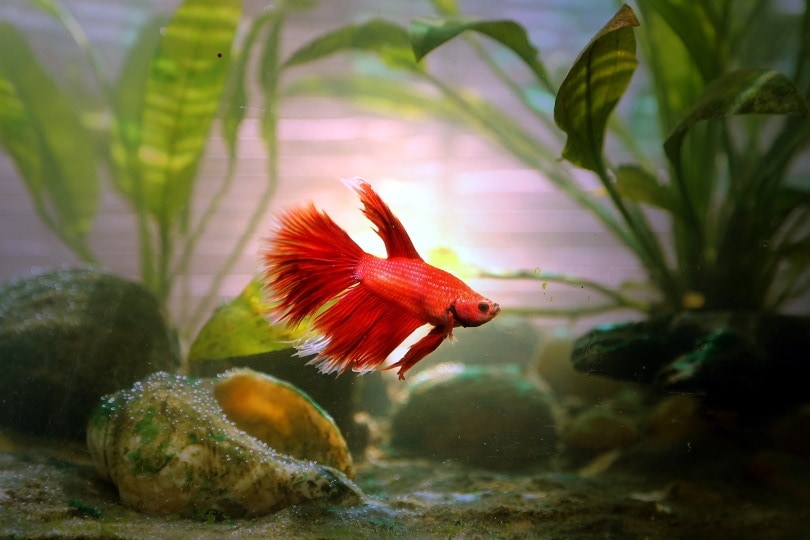
How Much Do Red Betta Fish Cost?
You’ll likely find that Red Betta Fish are hard to find. You probably won’t see them at big-box retailers since they are a species that enthusiasts would buy. They’re not as showy or popular as their cousin, the Siamese Fighting Fish. You can get them online or through a special order at your local aquarium shop. You can expect to pay at least $20 and upward of $30 or more.
Typical Behavior & Temperament
The Red Betta Fish differs from others in its genus in that it’s docile. You can keep these fish in a community tank or in pairs. They do have longer fins, so it’s essential to keep them with other peaceful species of a similar temperament. You can keep them in pairs or as part of a community tank. They will occasionally flare at each other, but they aren’t as aggressive as the Betta splendens.
Appearance & Varieties
The Red Betta Fish lives up to its name, with its attractive coloration. You’ll find them in a wide range of colors, from brown to scarlet red. Like other related species, the fish can change it with the living conditions and its mood. Some specimens have a greenish-blue spot on their sides. However, it’s not necessarily an identifying characteristic. Other species in the Coccina complex include:
- Betta miniopinna
- Betta hendra
- Betta brownorum
- Betta persephone
- Betta livida
You may or may not see the exact species identified. They are so similar in appearance that it can be difficult to determine, hence, the Coccina complex designation. There is some degree of sexual dimorphism between males and females. The former is often more colorful, whereas the latter may have a visible egg tube.
How to Take Care of Red Betta Fish
The Red Betta Fish is a tolerant species, especially given its living conditions in the wild. Another factor in its favor is its labyrinth organ. This respiratory structure allows the betta to breathe atmospheric oxygen. That gives this species an evolutionary advantage, considering the shallow waters in which it lives in the wild. That fact also makes the betta suitable as an aquarium fish, given the right conditions.
Habitat
The Red Betta lives in freshwater wetlands. It is a stenotopic species or one that has a limited habitat range. They typically inhabit shallow water bodies that often have decaying vegetation within them. Many plants are high in tannic acid, which will create an acidic environment. It will also dye the water to a tea-like color. Therein lies the challenge of setting up an aquarium for the Red Betta Fish.
Tank Size
A 5-gallon tank is big enough to house a pair of Red Betta Fish. If you want a community tank, you’ll need a larger one that is appropriate for the capacity. Bear in mind that the larger the aquarium, the less maintenance since the conditions will stay more stable than a smaller one. We suggest erring on the side of caution and going with a bigger tank. The extra space will act as a buffer.
Water Temperature
The Red Betta Fish’s geographic location and habitat provide valuable clues about what this species needs. It lives in a warmer climate and in shallow water. That means the optimal temperature is on the tropical end of the spectrum between 72℉–80℉. They can tolerate higher temperatures during breeding, which acts as a trigger to mate.
Water Chemistry
Creating the proper water chemistry is where the care for the Red Betta Fish goes from easy to moderate. They typically live in so-called blackwater conditions. That comes from the submerged vegetation coloring the water. You can replicate it by running a filter with peat media or a similar water conditioner.
The other concern is the pH. Red Betta Fish prefer acidic waters, which is a side effect of the discoloration from the plants. That often puts it in the 3.8–4.7 range. However, you’ll likely find that it’s problematic to maintain. Fortunately, the betta’s tolerance extends to the pH. Nevertheless, we recommend testing it often and using water treatment products to keep it on the low end.
Plants and Decor
As you may surmise, the vegetation in the water provides excellent cover for the Red Betta Fish. Because of their size and temperament, they are a prey species, making someplace to hide imperative. Wetland plants are suitable choices because that’s where they grow. Fortunately, you have lots of ones from which to choose, including duckweed.
We also suggest adding some hiding places for both the adult fish and the fry if a pair should mate in your tank.
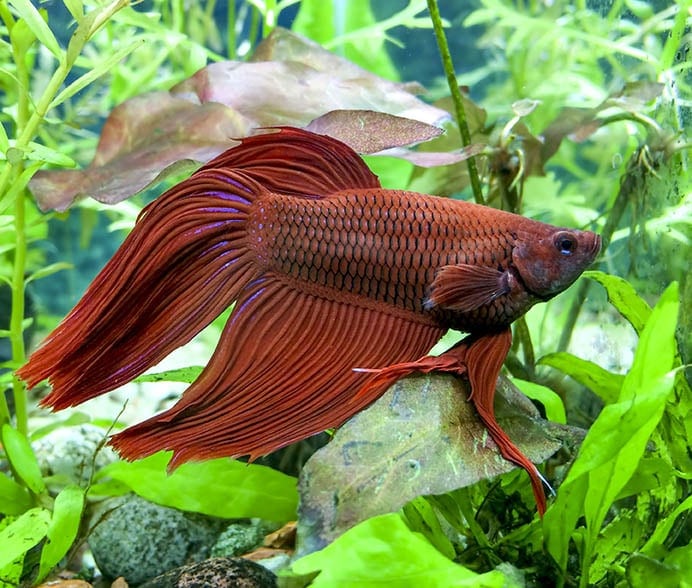
Are Red Betta Fish Good Tank Mates?
Red Betta Fish get along to varying degrees in part because they aren’t bred for fighting. Sure, they’ll flare at each other and put on a show. However, the squabbles are usually between members of the same species, although they may chase fish with long fins, such as Fancy Guppies. However, they aren’t necessarily picking a fight with any other tankmates.
Red Betta Fish do best with species that keep to themselves or school. Suitable choices include Corydoras Catfish, Neon Tetras, Harlequin Rasboras, and Platies. These fish will all do well and cause a fuss.
What to Feed Your Red Betta Fish
The Red Betta Fish is a carnivore. In the wild, they’ll feed on invertebrates and insects. We recommend a similar diet for your pets. They prefer live foods, such as brine shrimp. However, they’ll probably take some freeze-dried products, too. Make sure to remove any uneaten food to avoid fouling the water. Don’t be surprised if your betta doesn’t eat every day. That’s not unusual for meat-eaters.
Whether your betta takes processed foods depends on the individual. Many have that predator instinct in them that makes them associate feeding with the hunt. Pellets or flakes may not get the same response from them.
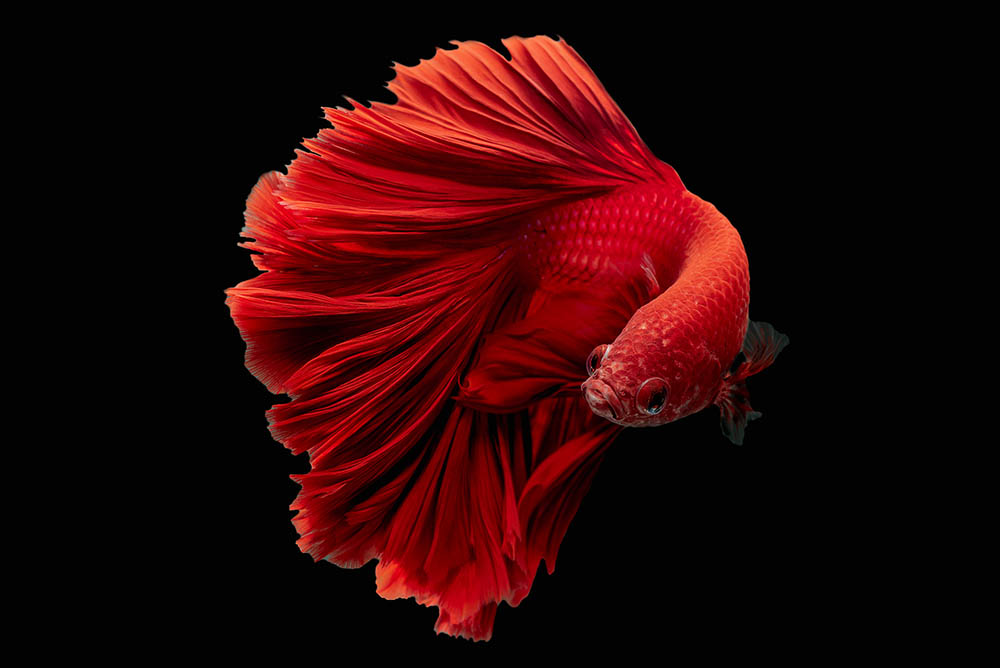
Keeping Your Red Betta Fish Healthy
Stable water conditions are the best way to keep your Red Betta Fish healthy. The right water chemistry is also vital for their well-being. That’s what makes testing your tank’s water so critical. You should plan on doing partial water changes at least every two weeks. Non-chlorinated water is best for species that don’t have the evolutionary past that would have adapted them to these chemicals.
Even though Red Betta Fish can tolerate less than ideal conditions, aerating the tank will ensure that the water has adequate amounts of dissolved oxygen. Even these fish need a minimum amount to survive.
Breeding
Like others in its genus, the Red Betta Fish is a paternal bubble nester. The male takes the lead and creates the nest. It will also make sure the eggs get to their protected area. You should remove the male after the young hatch. That’s where parental care ends. After that, the young are live food. Luckily, they mature quickly. However, only fish under a year will mate.
Are Red Betta Fish Suitable For Your Aquarium?
The Red Betta Fish is an excellent choice for intermediate to advanced hobbyists who want to take their skills to the next level. Your greatest challenge will be finding one. They aren’t terribly expensive. However, the species’ status in the wild raises the stakes considerably. If an import market still exists, it can drive up the price even higher. And if you’re determined to get one, you’ll find they make delightful pets.
- See Also: Brunei Beauty (Spotfin Betta)
Featured Image Credit: UNIKYLUCKK, Shutterstock




